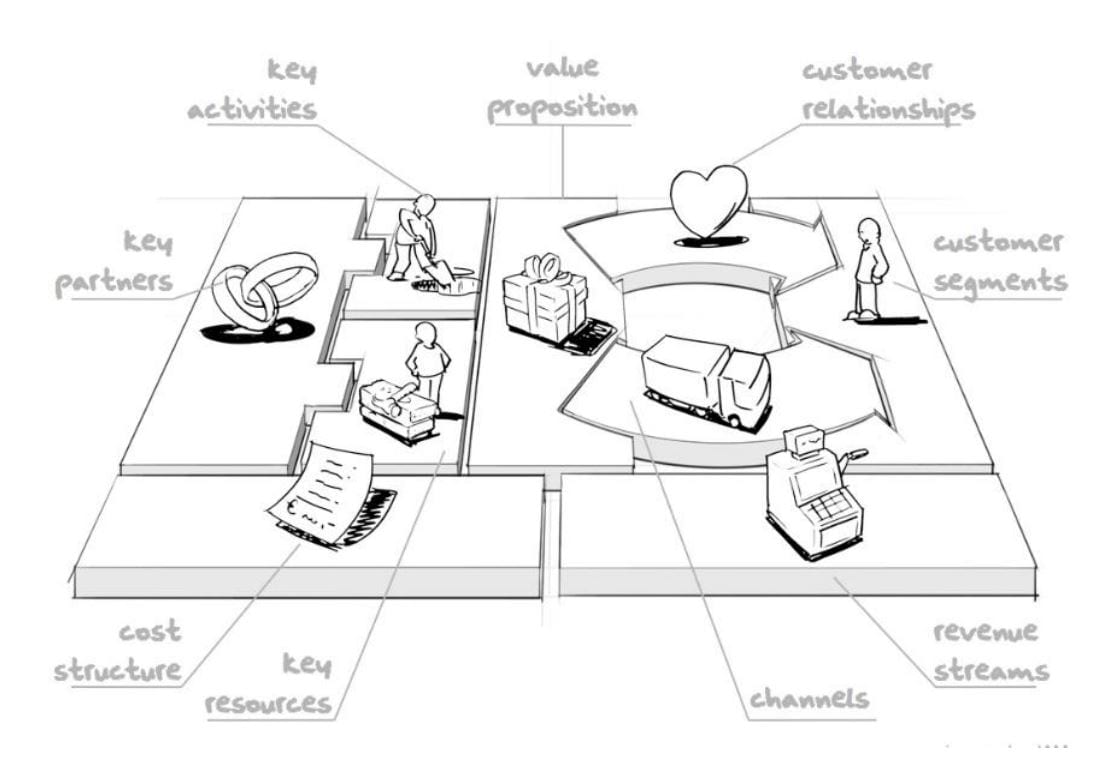Week 2:¶
Reminder: "Buisness is in the market satisfaction."

Custommer developpement to interact directly with the custommer segments.
Buisness modeling¶
Buisness model: methodology that describes how a company creates, delivers and captures value. It describes the exchange of value between a buisness and a market. The first version of the buisness is called a hypothesis.
Here is how we build a buisness model:

1) Custommer segment: who, style of life, budget... Do we want to focus on that segment or also on the other segments that might be interested? What is their pain?
2) Value proposition: solution (not the product !). How is the product incorporating the solution. What is the competitive advantage.
3) Channels: in what place am I going to offer the product. Usually, there are two channels: online and offline. Social media, physical space... To know where to sell, emphathize with the potential custommer! Where were they previously looking at when they wanted to solve their pain?
4) Customer relationships: how to fidelize the customer? How to show to the market what we are fighting for. How to keep contact pre and post sale (blog, newsletter...)
5) Key activities: what do we need to developp to make the product? How to guarantee that we are going to achieve our goal. What kind of research, production etc. Labels?
6) Key ressources: what kind of ressources are needed to make the key activities. Material ressources, human (workforce), infrastructures (what kind of company, size, production system), technological ressources (softwares, machines), transportation... Decide if it is done internally or outsourced.
7) Key partners: someone with whom there is a win-win relationship. There is a difference between supplier and partner. Who is allowing you to produce more cost, make you enter in the market faster... Explain the win-win relationship.
8) Cost structure: mention the most important cost concepts. What percentage reprensents the biggest part of cost of my product?
9) Revenue streams (=income model): what protocol am I going to my customer in order to pay? Product in exchange of money? Renting? Subscription? Try to be creative !
Examples of the most successful buisness models:
Here is my first version of my own buisness model:
The Purhyphae Project Buisness Model V1 par Sangosanya Annah-Ololade
Market research¶
1) Customer development.
Identify people who are part of the customer segment. Does the problem really exist? Is the pain real? How do you feel it, how do you react and how do you try to solve it? Are you looking for a solution and have you ever paid for it? Are you still looking for a solution or did the ones you found satisfy you? What did you love, what did you hate and what part is missing? How much money did you spend for previous solutions? What is the maximum price you are willing to pay? Would you pay more for a better solution? What are the attributes you are considering the most important in the solution they are looking for? Which brand is targeting which attribute? Who are the early evangelists ?
2) Custommer validation.
From all the interviews, define where I can find my custommers (names, emails, phone numbers etc). Finally, we can make a MVP (minimum viable product) and test sample so that you can have a feedback on that.
Early evangelists are people who DEEPLY suffer from the pain. The don't trust recommendation and want to test the product on their own, be the first ones to test it (example: ppl waiting in line to get the new apple products). They have the pain and know it, they already found a solution and are still looking for another solution and are willing to pay. You can only change your opinion if the person is an early evangelist, the rest do not matter.
Once you know your value proposition is valid and you start selling at the small scale (people are accepting the product), a Sales Road Map can be developped and we can start aiming at the mass market. Once done, you can scale up and shift from a start up to a company. The real difference between start up and company is the uncertainity. A company's product is already accepted by the market.
Interview questions google form :
- Are you trying to make your designs sustainable and how?
- Did you already find some solutions to making your designs more sustainable? Which ones?
- Did these solutions satisfy you? What did they lack?
- Are you looking for more solutions to make sustainable designs?
- How much money did you pay for the previous solutions?
- How much money are you willing to pay for a solution with the attributes you consider the most important?